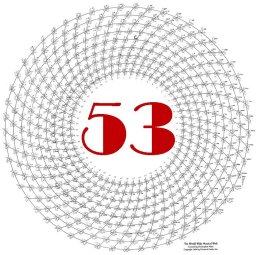Next Page: 2/4 – The Harmonic Lattice
Ancient China
One can speak of music only with one who has recognized the true purpose of the world. –Lu Bu Ve
The discovery of the harmonic series was lost in antiquity. The first culture to discover it may have been ancient Egypt, or Mesopotamia, or China. It was almost certainly discovered independently in the separate cradles of Eastern and Western civilizations. We do know that around 2700 B.C., the Chinese Ling Lun, court musician to Emperor Huang-Ti, standardized a pentatonic (five-note) scale strictly based on the third harmonic (the perfect fifth). He considered this to be the only true consonance and rejected the harmonic possibilities of the fifth harmonic (thirds) and higher. This is the first example we know of of a “three-limit” scale—in other words, one whose relationships derive from nothing higher than the third harmonic. Fortunately for us, he used ratios to clearly define the tunings of every note of his scale, a practice employed by many other mathematicians/music theorists in ancient cultures around the world, and the only truly precise system of musical notation ever developed. His bamboo pipes employed the ratios 1/1 (In the key of C, this would be C), 9/8 (D), 81/64 (E four perfect fifths up from C), 3/2 (G), 27/16 (A three perfect fifths up from C), and 2/1 (C an octave higher). Figure 2-5 is a visual and auditory representation of this most ancient of the known scales.
Figure 2-5 C (1/1) – G (3/2) – D (9/8 – A (27/16) – E (81/64)
All of Chinese music relates to the unchanging Primal Vibration (which is represented dronally as the fundamental tone of the overtone series). The ancient Chinese also developed a twelve-note chromatic scale around the same time, which also became the basis for the first known astrological system. They believed that each body has a sound, and that musical harmony is about relatedness and balance of the forces of yin and yang (feminine and masculine)…
If you would like to learn more about this chapter, “Ancient China,” you can buy the entire book, The Grand Unified Theory of Music, in pdf form for $25 with hundreds of embedded musical examples of scales and chords from all over the world.
A free introduction to what The Grand Unified Theory of Music offers is on this website and includes both text and a few musical examples from each webpage. If you would like to learn more about this chapter and the full contents of this entire e-book, you can buy The Grand Unified Theory of Music for $25, with hundreds of embedded musical examples of scales and chords from all over the world — and ideas for how to set up your computer system —
HERE.
You’ll get a personalized password you can use to see the entire e-book. Inside the full book, you will also get a link to the complete pdf file of this e-book, which you can read on your Kindle or similar device. The links to the hundreds of mp3 sound files – the same ones you can hear on the website — will also be included. This is “Version 1.0” of The Grand Unified Theory of Music. Because it is an e-book, additions, corrections and improvements in the sound may be added at any time. The Grand Unified Theory of Music is Copyright © 2018 by Christopher Mohr. All rights reserved.
One person per password. Sharing this password with others is a violation of copyright. Do not allow others to use your password or link to the pdf file!
